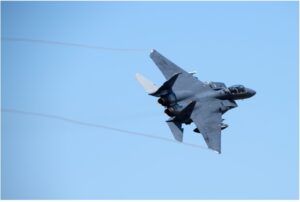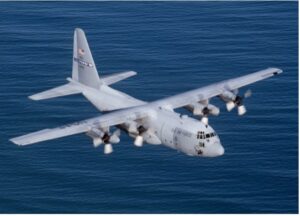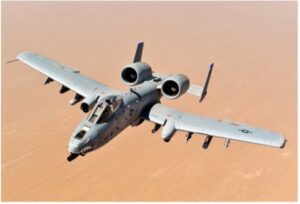During the Second World War, the aircraft of the United States (U.S.) Army Air Force famously dominated the skies over Europe and the Pacific, destroying thousands of enemy fighters, bombers and ground assets. The sheer number of airplanes produced by the U.S. more than doubled those which enemy forces produced altogether, amounting to nearly 310,000 aircraft over the course of the war.
 Among these critical aircraft were the P-51 Mustang, P-38 Lightning and P-40 Warhawk. These planes often provided diverse functions, such as dive-bombing troops on the ground, escorting bombers to their targets in enemy territory, taking reconnaissance imagery and clearing airspace of opposing aircraft. These pursuit aircraft have slowly evolved into their more advanced cousins such as the F-16 Fighting Falcon and F-15 Eagle. As many may already know, the letter at the front of the plane name stands for its purpose. The “P” for “pursuit” and “F” for fighter seems to infer different roles, but the versatile usage of these planes has remained similar over time. So why are ‘pursuit’ aircraft known as ‘fighter’ or ‘attack’ aircraft today?
Among these critical aircraft were the P-51 Mustang, P-38 Lightning and P-40 Warhawk. These planes often provided diverse functions, such as dive-bombing troops on the ground, escorting bombers to their targets in enemy territory, taking reconnaissance imagery and clearing airspace of opposing aircraft. These pursuit aircraft have slowly evolved into their more advanced cousins such as the F-16 Fighting Falcon and F-15 Eagle. As many may already know, the letter at the front of the plane name stands for its purpose. The “P” for “pursuit” and “F” for fighter seems to infer different roles, but the versatile usage of these planes has remained similar over time. So why are ‘pursuit’ aircraft known as ‘fighter’ or ‘attack’ aircraft today?
It comes down to a use of combat doctrine and linguistics.
During the Second World War, the U.S. Army Air Service adopted the term “pursuit” for aircraft that modeled the concept, the French Avion de Chasse, or hunt airplanes. The French Air Force continues to use this term to describe aircraft, but after the war, the newly created U.S. Air Force redesignated the “P” designation as “F” for fighters. Though the historical evidence is unclear, it is possible that the U.S. Air Force wanted to use more aggressive language to describe the role of its aircraft. The term “pursuit” in the English language could imply a passive or reactionary response, which doesn’t fully encompass the multitude of roles that modern combat fighters undertake. Meanwhile, labeling the aircraft a “fighter,” alludes to a more combative performance.
 Ultimately, the use of aircraft designations are often semantics. Aircraft initially designed for one aspect of warfare can be modified and reassigned as needed, whether by necessity or innovation. A good example of this flexibility is the venerable C-130 Hercules. Originally the C-130 was a cargo aircraft which the U.S. Air Force first used in 1954. However, since then, different military entities in the U.S. have outfitted the plane as an attack aircraft (AC-130), for weather reconnaissance (WC-130); as a refueling station (KC-130); and as a temporary bomber, air-dropping parachuted bombs out its rear cargo bay door in flight. Despite these semantics, the role of the pursuit aircraft did slowly hone into two different genres of versatility: attack aircraft and fighter aircraft.
Ultimately, the use of aircraft designations are often semantics. Aircraft initially designed for one aspect of warfare can be modified and reassigned as needed, whether by necessity or innovation. A good example of this flexibility is the venerable C-130 Hercules. Originally the C-130 was a cargo aircraft which the U.S. Air Force first used in 1954. However, since then, different military entities in the U.S. have outfitted the plane as an attack aircraft (AC-130), for weather reconnaissance (WC-130); as a refueling station (KC-130); and as a temporary bomber, air-dropping parachuted bombs out its rear cargo bay door in flight. Despite these semantics, the role of the pursuit aircraft did slowly hone into two different genres of versatility: attack aircraft and fighter aircraft.
What Is a Fighter Plane?
Modern military aircraft, colloquially known as fighters, fill a variety of roles, each with a specific task in the overlapping domain of total air domination and battlefield success. Fighters can even fill multiple roles, known as a “multi-role fighters.” These aircraft are designed from the onset to shift from interceptor to ground-attack aircraft to bomber. Meanwhile, other aircraft are designed to excel in one role only, such as the A-10 Thunderbolt II, B-2 Stealth Bomber or the F-22 Raptor. Each aircraft is wildly different and equally capable of carrying out their mission.
What Is an Attack Plane?
 Typically referred to as attack, or ground-attack aircraft, this variety of airframe is designed to work in direct support of ground troops and typically carries large quantities of bombs and other munitions used for the express purpose of destroying ground targets. The most well-known of these aircraft, the A-10 Thunderbolt II, is famous for destroying armored vehicles with ease thanks to its massive Gatling gun.
Typically referred to as attack, or ground-attack aircraft, this variety of airframe is designed to work in direct support of ground troops and typically carries large quantities of bombs and other munitions used for the express purpose of destroying ground targets. The most well-known of these aircraft, the A-10 Thunderbolt II, is famous for destroying armored vehicles with ease thanks to its massive Gatling gun.
What Was the Role of Pursuit Planes?
 Though the name implies a defensive position rather than a proactive one, the pursuit aircraft of the Second World War filled several roles, including air-domination fighter, interceptor, fighter-bomber, dive-bomber in ground attacks and long-range escorts. Aircraft such as the P-51 Mustang, P-40 Warhawk and P-38 Lightning were all pursuit aircraft that each excelled in a variety of missions. The P-40 Warhawk saw the widest service in WWII because it surpassed other pursuit aircraft in flying competitions in the late 1930s. The P-38, first produced in 1943, found success as both a long-range escort aircraft in the Pacific, and as a ground attack fighter. Echoing the P-38, the P-51 Mustang escorted bombers into Germany during WWII, and continued service for some non-American air forces into the 1980s.
Though the name implies a defensive position rather than a proactive one, the pursuit aircraft of the Second World War filled several roles, including air-domination fighter, interceptor, fighter-bomber, dive-bomber in ground attacks and long-range escorts. Aircraft such as the P-51 Mustang, P-40 Warhawk and P-38 Lightning were all pursuit aircraft that each excelled in a variety of missions. The P-40 Warhawk saw the widest service in WWII because it surpassed other pursuit aircraft in flying competitions in the late 1930s. The P-38, first produced in 1943, found success as both a long-range escort aircraft in the Pacific, and as a ground attack fighter. Echoing the P-38, the P-51 Mustang escorted bombers into Germany during WWII, and continued service for some non-American air forces into the 1980s.
Pursuit Aircraft at Hill
The local team at Hill Field (now Hill Air Force Base) was responsible for maintaining and repairing many of the 310,000 planes the U.S. produced. Hill Field’s motto, “We keep ’em Flyin’ and Fightin’, illustrated the essential role that the maintenance depot played in keeping American airmen alive and well by keeping their planes working smoothly. The P-51 Mustang, P-38 Lightning and P-40 Warhawk, though not all stationed at Hill, each had an essential function or part which was Hill’s job to repair. For example, Hill Field repaired the engine of the North American P-51 Mustang through the conflict, and then stored the engines for future use after demobilization. The installation also performed maintenance on the engines of the P-38, and overhauled hundreds of P-40s during the war.
Conclusion
The designated roles of aircraft such as pursuit, fighter, attack, bomber, cargo and others do not always fully encompass the adaptable scope of what an aircraft can perform in a conflict, or what they will later become. Identifying what an airplane was meant to do in history, and what it is meant to do now, often requires an understanding of the context of war, and the advancements that occur in technology over time. The pursuit aircraft of World War II, though performing many versatile duties, did not have to overcome the advancements of radar detection that our fighters have to ward off today. Each new conflict seems to require a different advance in aerospace and military technology. Despite these changes over time, fighter and attack aircraft of today are continuing the tradition of remaining versatile in the face of new conflicts and new missions.
